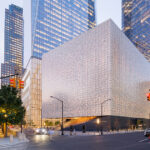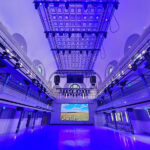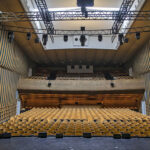Described as a Sputnik-size satellite by CNN’s Emmy Award-winning journalist Tom Foreman, the floating box rotates along an invisible axis, like some square, metallic rotisserie chicken. Further into the segment, Foreman explains that a test launch of a three-stage, liquid-fuel Unha rocket places North Korea ever so slightly closer to having the ability to strike the West Coast of the United States with a nuclear weapon.
Moments later, with computer-generated 3D graphics surrounding him, Foreman waves his hands and seemingly conjures and conducts a series of visual events, including the sudden appearance of a world map that is cast on the studio floor (at least what we perceive to be the studio floor), featuring concentric circles denoting the distance in miles from a theoretical North Korean detonation point. These ringlets — and the entire report — underscore the notion that a national crisis could be only a missile launch away.
It’s clear: Thanks to Foreman and the CNN’s new Virtual Studio, the network doesn’t just bring us the news — they demonstrate it visually for live broadcast. “The real value of this tool [The Virtual Studio] is that it allows us to explain concepts in a visual way, and do what historians describe as ‘walking the battlefield,’” Tom Foreman tells PLSN. “It’s saying, ‘I know you can’t go to North Korea right now. I know you can’t go to Syria right now, but we can give you a much more hands-on feel for what we’re talking about.’”
» Virtues of Virtuality
The virtual set (located in the network’s Washington bureau) is another bold step in the evolution of CNN’s visual-technology development. In 2008, CNN set the Internet buzzing when it tapped Vizrt Virtual Studio software (in conjunction with other broadcast technologies) to help create its so-called holographic effect for the network’s Presidential Election Night coverage. By the fall of 2012, The Virtual Studio began employing green-screen and motion capture software technology to present what could be the most technically demanding production operations attempted by CNN for live broadcast.
Says senior producer Joshua Braun, the virtual studio takes advantage of existing mechanical tracking and optical IR tracking cameras and motion-capture devices, which have been used in slightly different ways by CNN for prior projects and news segments.
 The composited visuals that appear in The Virtual Studio seem (dare we say) dynamic, not static. There are multiple reasons for this: the choreography involved, Foreman’s economical motions, the use of the proper camera angles relative to the virtual background and Foreman’s position at any given moment, and rehearsals that go into making each live segment fresh and visually rich, not cluttered or dense. Simply put, Foreman convinces us that he’s in a set with real props and objects, some of which miraculously pop up out of nowhere on our TV, iPhone and tablet screens.
The composited visuals that appear in The Virtual Studio seem (dare we say) dynamic, not static. There are multiple reasons for this: the choreography involved, Foreman’s economical motions, the use of the proper camera angles relative to the virtual background and Foreman’s position at any given moment, and rehearsals that go into making each live segment fresh and visually rich, not cluttered or dense. Simply put, Foreman convinces us that he’s in a set with real props and objects, some of which miraculously pop up out of nowhere on our TV, iPhone and tablet screens.
“Editorially, there are lots of concepts that are complex … and we’d like to show all of the complexities of a story while making these segments interesting for the viewers,” says Eric Sherling, CNN director of Washington programming.
“The driving force for humanity is visual cues: that’s how we navigate our world,” says Foreman.
 When CNN wanted to describe the “battle for control” of Congress on Presidential Election Night 2012, it brought the viewer to the floor of The U.S. Senate, (virtually) making history. We say “virtually,” because no one, other than U.S. Senators, is actually allowed on the Senate floor. This could have been a nonstarter had The Virtual Studio crew adhered to the traditional newsroom approach.
When CNN wanted to describe the “battle for control” of Congress on Presidential Election Night 2012, it brought the viewer to the floor of The U.S. Senate, (virtually) making history. We say “virtually,” because no one, other than U.S. Senators, is actually allowed on the Senate floor. This could have been a nonstarter had The Virtual Studio crew adhered to the traditional newsroom approach.
So, how did CNN skirt the law of the land? By studying the chamber from the observation area, producers were able to replicate it in relative detail in 3D graphics programs. “The virtual set allows us to go to places where we can’t even take a camera,” says Foreman.
“Having Tom walk around this virtual Senate chamber was done to explain how changes in the makeup of the Senate would impact policy,” Sherling adds. “There were so many different permutations involved, we had to be prepared for a Romney presidency and an Obama presidency; a Republican-controlled Senate and a Democrat-controlled Senate.”
» Function and Form
The Virtual Studio, which has been featured on numerous live broadcasts over the last six months, was spawned by the necessity to explain all the complexities of the 2012 Presidential Election cycle.
“We were monitoring the Republican Primary and, I think, Newt Gingrich [former Speaker of the House/2012 Presidential hopeful] began talking about the prospect of a brokered convention,” says Sherling. “We wanted to figure out a way to … explain that concept on TV. One of the things I discussed with Josh [Braun] and with Tom [Foreman] and others is that maybe we could do these things using green-screen technology to create a virtual convention for Super Tuesday [which occurred in March 2012]. Ultimately, we created this [virtual] convention hall in Tampa. As the night wore on, on Super Tuesday, you could see Mitt Romney sort of gaining in the virtual convention, which seemed to indicate that he had a leg up. We came away from that experience thinking, ‘We’re really proud of what we were able to do.’ We went to our bosses at CNN and said there’s real editorial value in having this. When they agreed, we decided to go shopping for one.”
Shopping for a virtual set meant, in part, scoping out and scooping up products at the 2012 National Association of Broadcasters (NAB) conferences and exhibition show as well as rummaging through under-utilized in-house equipment and tools. Although some on the CNN staff are quick to point out that the D.C. studios are nothing out of the ordinary, these standard, low-ceiling office spaces offer all the room required to coordinate live broadcasts. The Virtual Studio and its neighboring control room may not be swanky, expansive suites, but then again, they don’t need to be. The technology used can, of course, make imagery appear as anything, anywhere, at any given time. By the same token, the production crew must ensure that visuals don’t overtake the story.
“Over and over and over again, we recite the architectural mantra of ‘form following function,’” says Foreman. “I’m sure a lot of what we do is impressive to look at, but in every single thing we do, we [ask] ourselves, ‘Is there a reason to do this?’ If I wanted to, I could have a parade of elephants through the room and it would be really fun to watch, but it would serve no purpose.”
 The Virtual Studio and its computer software-generated 3D graphics were highly effective in testing the veracity of each candidate’s statements during the Presidential debates. One broadcast of Foreman’s Cronkite/Jackson Prize-winning segment, “Reality Check,” which aired during The Situation Room in October 2012, examined President Obama’s and Mitt Romney’s political position on Iran’s nuclear program. Rather then simply describe the intricacies of this politically charged powder keg, Foreman demonstrated the magnitude of this potential danger by standing next to a life-sized 3D virtual image of an Iranian Shahab-3 mid-range ballistic missile and launcher. When a geographic map of the Middle East appeared, it was blanketed in red shading, depicting the missile’s striking range.
The Virtual Studio and its computer software-generated 3D graphics were highly effective in testing the veracity of each candidate’s statements during the Presidential debates. One broadcast of Foreman’s Cronkite/Jackson Prize-winning segment, “Reality Check,” which aired during The Situation Room in October 2012, examined President Obama’s and Mitt Romney’s political position on Iran’s nuclear program. Rather then simply describe the intricacies of this politically charged powder keg, Foreman demonstrated the magnitude of this potential danger by standing next to a life-sized 3D virtual image of an Iranian Shahab-3 mid-range ballistic missile and launcher. When a geographic map of the Middle East appeared, it was blanketed in red shading, depicting the missile’s striking range.
As anchor Blitzer and Foreman discussed economic sanctions imposed on Iran, Iranian currency flashed up on the screen, as if encased in a block of glass, followed by a pop-up line chart (which was given dimension thanks to virtual modeling programs). In some instances, onscreen graphics materialized in front of Foreman. The segment hardly needed words to demonstrate the impact of economic sanctions and the strength of the dollar relative to the Iranian Rial.
“This [technology] takes complex ideas and turns them into visual information,” says Foreman. “That’s why I like it.”
» On the Right Track
CNN is mum about the finer technical details of The Virtual Studio and how it creates graphic environments for it, except to say that motion analysis software, initially designed for the skeletal tracking of humans, was customized to suit the needs of the virtual studio.
Tracking software recognizes Foreman no matter where he stands in the set’s 20-foot-by-20-foot space. Tracking data is then being sent to a graphics system that combines the “keyed out” video with positional data (Foreman’s movements) and runs it through Vizrt software. The actual 3D modeling of the objects seen on your TV is done in programs such as Autodesk Maya 3D Animation software, Maxon’s Cinema 4D and Adobe Photoshop, which are imported into the Vizrt environment.
While the studio’s infrared capabilities haven’t been fully integrated, the combination of a “well-coordinated control room” with Foreman’s reporting skills and the capabilities of the motion capture system makes for highly synchronized segments for live TV.
“The value of having the control room next to The Virtual Studio at CNN is that we have a finished product when it leaves that virtual control room,” says Sherling. “It can be sent to a show that’s being produced in New York, or Atlanta, or, theoretically, to the CNN International control room in London. Having this capability allows the anchor to interact with Tom just as Tom is interacting with his virtual environment.”
» Core Values
The crew working in The Virtual Studio has overcome some very tight turnaround times in the last several months, and still managed to lead with impressive visuals. Within a matter of hours, the virtual team used graphics to depict a wind tunnel effect on Manhattan skyscrapers for CNN’s Hurricane Sandy coverage. In another story, 3D meteorites, similar to the one that entered into Earth’s atmosphere and exploded over Russia in February 2013, were seen floating in the studio.
More recently, the process by which the papal conclave picks a new Pope was parsed, and Foreman reported from inside what appeared to be the Sistine Chapel, “under” a virtual mockup of Michelangelo’s famous fresco. During the information-rich segment, Foreman deposited an actual stack of paper meant to represent Roman Catholic Cardinals’ voting ballots. These “ballots” disappeared into the mouth of the furnace — an actual opening built into the set. While Hollywood producers, set designers and graphic artists have pioneered and perfected such maneuvers over several decades, it’s impressive that CNN has the ability, for live TV, to navigate the technical nuances of the relationship between composited backgrounds and physical objects/space.
“Most of the people who come into the room, truly even most technical people who come into the room, ultimately leave shaking their head, saying, ‘I’m not sure how you’re doing this,’’ says Foreman. “That’s why it’s so important that the little core of people understand how it’s done.”
It’s certainly a tight-knit (and, evidently, tight-lipped) group. Editorial and production crews even communicate amongst themselves using terms that have been created specifically for The Virtual Studio setting. “In six months we’ll have a glossary of terms,” says Foreman.
“It’s a real team effort,” says Sherling. “Tom has a sense of how he can add editorial value, and his team will say, ‘That might not work. Let’s try it this way…’”
“I’ve seen a lot in the industry,” Foreman says. “This is an amazing investment by CNN in an amazing idea, and we’re really just starting to see what we can do with it.”
Foreman is already thinking about applications for handheld devices and the Web. “We’re talking about a number of mechanisms by which we would do this, but I would like you to be able to pull the virtual environment into your smartphone,” says Foreman. “More importantly, I would like to embed in that environment my notes and links of information… I think this technology helps us [move] in that direction.”


